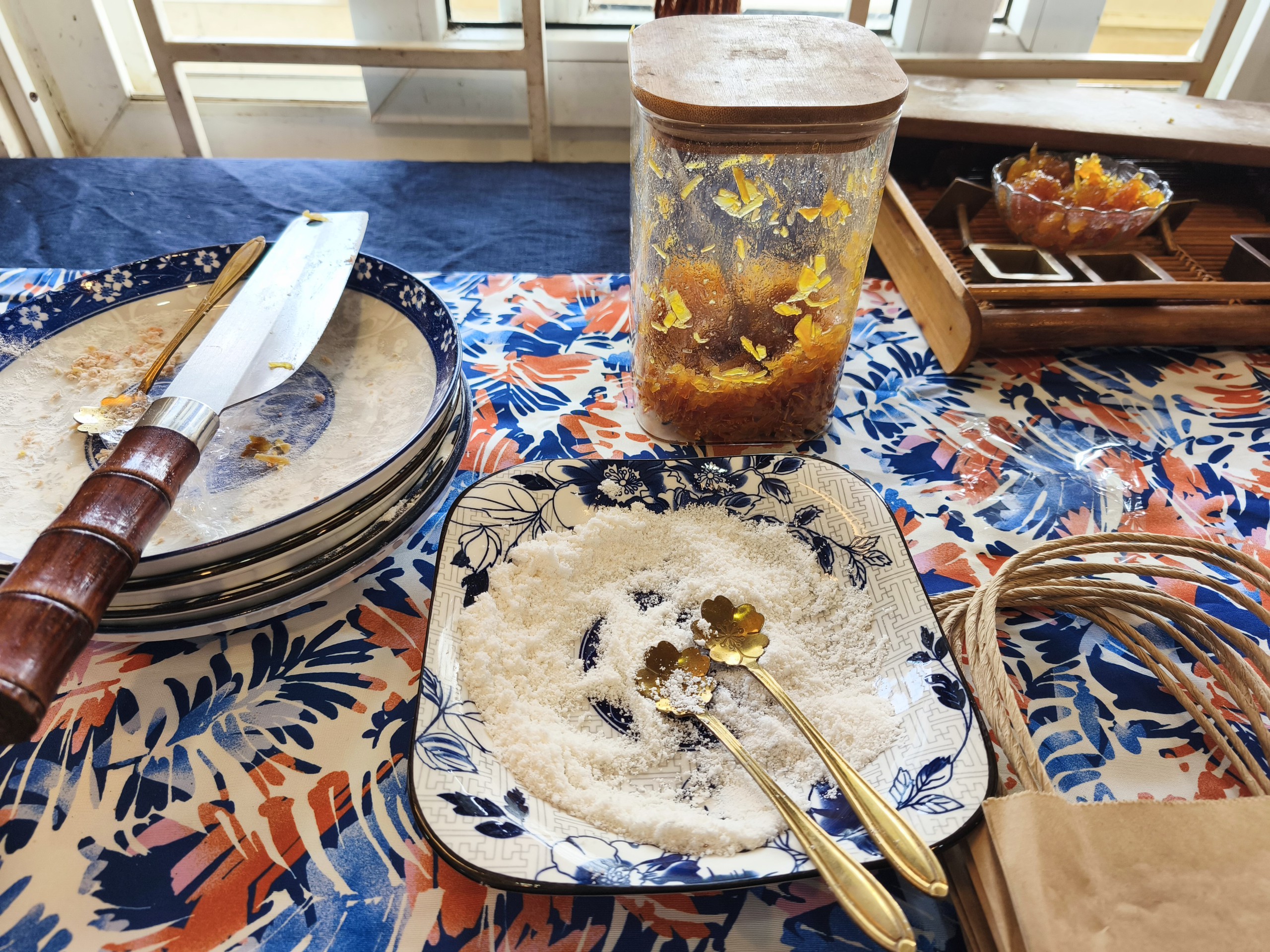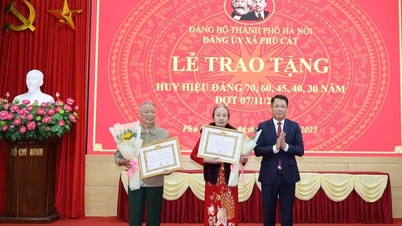STRANGE "CHUTTER AND LISTEN" CAKE
In Ma's House space in Bao Vinh ancient town (Phu Xuan district, Hue city), Ms. Phan Nu Phuoc Hong gently put the candied star anise powder into a small bronze mold and pressed the lid down hard on the powder. Then, she removed the mold, revealing the ancient, sharp patterns. Witnessing Ms. Hong making Poria cocos and telling about the meaning of each cake, the French tourists were "eyes wide open". They were excited to experience and bring back pieces of cake that they had molded themselves. "During the days before Tet like this, I choose to introduce and let visitors participate in the steps of making Poria cocos, thereby helping them understand more about the traditional Tet holiday of the nation", Ms. Hong shared.

Ms. Phan Nu Phuoc Hong demonstrates how to make Poria cocos cake for French tourists.
As a nostalgic person and a lecturer in culinary arts (Hue College), Ms. Phuoc Hong is knowledgeable and often makes ancient cakes. She believes that the fu ling cake is a typical example of the exchange of cake-making art between regions. The way to make fu ling cake is similar to the way to make banh khao in the North, but the basic ingredients are different. If in the North it is roasted sticky rice, then Hue people only make it with tapioca starch. Since the Nguyen Dynasty, fu ling cake has been elevated when it is used in the offerings at palaces and royal courts with a more luxurious material, lotus seed flour, replacing tapioca starch. Since then, this type of cake has become diverse in decorative patterns. Depending on the occasion of worship or tea party, the cake will be printed with the words "Phuc", "Loc", "Tho", "Double Happiness", or drawings of flowers...
“My family still keeps an ancient bronze mold with a dragon printed on the cake. Only families from the royal family have this type of cake mold,” said Ms. Hong. According to the explanation of the famous culinary artist of Hue – Mai Thi Tra (92 years old), the Chinese name of the arrowroot root is Poria cocos, the cake is made from arrowroot powder so it is called Poria cocos cake. “Hue’s Poria cocos cake is made purely from arrowroot powder and white sugar, not using tapioca starch and coconut milk like in the South. The cake is crispy and melts quickly in the mouth, has a cool taste, and a light aroma,” Ms. Tra further analyzed.
As someone who tasted this cake in the 90s of the last century, I can never forget the flavor of each cake. What I remember most is when I bite into a piece of cake and hold it in my mouth, the tapioca starch just melts without chewing, sweetening the palate. The cake does not need any fancy jam filling, nor is it elaborately prepared, but it leaves a deep impression on many people, perhaps because of the way it is enjoyed, "taking it in and listening to it".
Cherish the white cake
Old artisan Mai Thi Tra gives detailed instructions for those who want to make standard Hue-style fu ling cakes. First, you need a rectangular bronze mold with decorative carvings inside. Prepared ingredients include 500 grams of tapioca starch, 400 grams of white sugar, 10 pandan leaves, and white mirror paper. “Peacock starch can be steamed or roasted with pandan leaves for fragrance. If roasted, the dough is ready when the leaves are crispy. Add sugar and 1 cup of water and cook until thick, let cool and grind until smooth. Sift the flour into a tray, add sugar and mix well, then rub until smooth. Leave for a while for the sugar and flour to absorb each other, then print the cake,” Ms. Tra imparted.

Poria cocos cake with pure white powder wrapped in transparent mirror paper

Star anise powder - the main ingredient to make Poria cocos cake

Exquisite copper fu ling cake mold with printed lids
The cake printing process requires placing the mold in the tray so that the dough is full, pressing the lid to secure the cake. To have a beautiful, clear pattern, use two thumbs to press and rotate the cake to secure it evenly. Two thumbs press down the lid, two index fingers pull up the mold and then take out the cake; place the cake on a flat surface lined with clean paper to dry until crispy. "Wrap the cake in white mirror oil paper to distinguish it from other types of lotus cake. Poria cake belongs to the dry type of cake, can be used for a long time", said Mrs. Tra.
The process of making the cake does not sound difficult at first, but according to the story of People's Artisan Hoang Thi Nhu Huy, in the past, to have a white fu ling cake wrapped in cellophane, the process of making tapioca starch was extremely hard. When the harvest season came, Mrs. Nhu Huy's sisters dug up the long, slender, white-fleshed tapioca starch tubers, containing a lot of starch... Then, they cut and peeled them, crushed them, then mixed them all with clean water, filtered out the fibers, and only took the liquid powder solution like milk, let it settle to the bottom of the container, and drained it. Continue to add clean water, stir well, settle, drain the water a second and third time to make the powder really smooth. After that, the powder was dried in the sun.
“High-quality flour is completely dry, light and smooth when rubbed by hand. Tapioca starch is a good food, providing many nutrients and easy to digest for all ages,” Ms. Nhu Huy shared. Through field trips, researcher Tran Nguyen Khanh Phong was informed by artisans that in order for the cake dough to be fluffy and fragrant, the steaming stage must be very careful to avoid letting water drip into the dough tray. When cooking sugar, stir constantly until smooth. When eating a delicious cake, you will feel the cool taste of the flour melting in your mouth.
Ms. Phuoc Hong misses the glorious past of Hue's old Tet cakes. Over the years, she has tried to research, experiment and successfully make many types of cakes, including Phuc Linh cake. "I welcome groups of tourists and students to experience making cakes with the hope of spreading the quintessence of Hue cuisine, so that everyone knows that Hue used to have such delicious cakes," Ms. Hong confided.
Source: https://thanhnien.vn/giu-huong-tet-xua-hoi-sinh-banh-phuc-linh-185250119223545888.htm


![[Photo] Ho Chi Minh City Youth Take Action for a Cleaner Environment](https://vphoto.vietnam.vn/thumb/1200x675/vietnam/resource/IMAGE/2025/11/04/1762233574890_550816358-1108586934787014-6430522970717297480-n-1-jpg.webp)
![[Photo] Ca Mau "struggling" to cope with the highest tide of the year, forecast to exceed alert level 3](https://vphoto.vietnam.vn/thumb/1200x675/vietnam/resource/IMAGE/2025/11/04/1762235371445_ndo_br_trieu-cuong-2-6486-jpg.webp)
![[Photo] The road connecting Dong Nai with Ho Chi Minh City is still unfinished after 5 years of construction.](https://vphoto.vietnam.vn/thumb/1200x675/vietnam/resource/IMAGE/2025/11/04/1762241675985_ndo_br_dji-20251104104418-0635-d-resize-1295-jpg.webp)
![[Photo] Panorama of the Patriotic Emulation Congress of Nhan Dan Newspaper for the period 2025-2030](https://vphoto.vietnam.vn/thumb/1200x675/vietnam/resource/IMAGE/2025/11/04/1762252775462_ndo_br_dhthiduayeuncbaond-6125-jpg.webp)




























































































Comment (0)